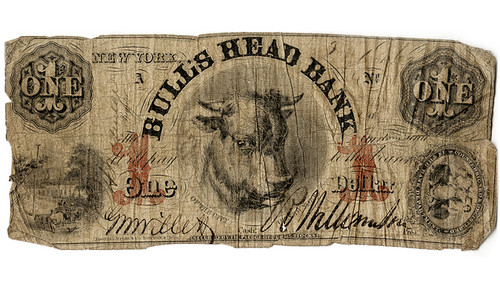
PREV ARTICLE
NEXT ARTICLE
FULL ISSUE
PREV FULL ISSUE
OBSOLETE BANKNOTE EXHIBIT: CAPITAL OF CAPITAL: NEW YORK’S BANKS
Bloomberg published a nice article this week on obsolete banknotes and an exhibit of them at the Museum of the City of New York. Here are some excerpts. Great images! Be sure to have a look online.
-Editor

Before the institution of federally backed paper currency in 1862, the government didn’t see issuing paper money as its responsibility. Although it coined gold and silver, there was never enough in circulation to provide an effective medium of exchange. Because the Constitution prohibited states from printing money, banks became the primary suppliers of paper money in the U.S. From 1791 to 1811, and then again from 1817 to 1836, the First Bank of the United States and the Second Bank of the United States brought a degree of order to this system, both regulating the issue of bank notes and issuing their own trusted notes. But when Andrew Jackson failed to renew the second bank’s charter in 1836, private bank notes proliferated unchecked. By the 1850s, U.S. banks had issued more than 10,000 kinds of bank notes, varying in size, denomination, design and value. (Many of them are now on display at the Museum of the City of New York.) When banks couldn’t provide an adequate supply of money, other institutions stepped in. In particular, there was demand for small-denomination bank notes and coins. (In 1840, per- capita annual income in the U.S. was about $65, so a $1 bank note was a lot of money.) Hotels, restaurants and bars that didn’t have enough coins and bank notes to make change issued their own money in small denominations. A note issued by one hotel promised “to pay on demand twenty five cents in current funds when presented in sums of $1 & upwards.” A note worth 25 cents in the hotel lobby would have changed hands at a steep discount just a few blocks away. Meanwhile, small towns issued bank notes of a few cents to support local commerce. In Virginia, people were reduced to cutting apart large bank notes and circulating them in pieces.

In this unpredictable environment, spending a dollar required some serious thinking. A wallet might have three, five or a dozen different bank notes -- a bull’s head staring back at you from a Bull’s Head Bank note, or a Marine Bank bill illustrated with ships -- not to mention foreign coins from around the world and personal checks, which also circulated as money. Most bank notes traded at a discount based on the reputation of the bank and how far the note was from where it originated.
To read the complete article, see:
When Banks Were Able to Print Their Own Money, Literally
(www.bloomberg.com/news/2012-10-19/when-banks-were-able-to The Numismatic Bibliomania Society is a non-profit organization promoting numismatic literature. See our web site at coinbooks.org. To submit items for publication in The E-Sylum, write to the Editor at this address: whomren@gmail.com To subscribe go to: https://my.binhost.com/lists/listinfo/esylum All Rights Reserved. NBS Home Page Contact the NBS webmaster 
|